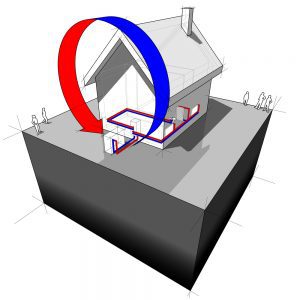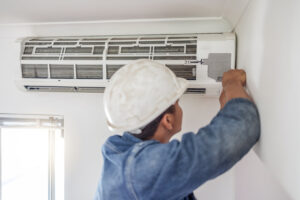Radiant Floor Heating Systems
Your home uses energy every day for heating and cooling, lighting and hot water, and appliances and electronics. According to the U.S. Department of Energy, “Heating your home uses more energy and costs more money than any other system in your house – typically making up about 42% of your utility bill.” But properly maintaining and upgrading your heating system can save you money and increase your comfort. A variety of technologies are available for heating your house. However, radiant floor heating systems are often preferred because they are inconspicuous, effective, and long-lasting.

How Does It Work?
Radiant floor heating systems supply heat directly through the floor. They largely depend on radiant heat transfer, where heat flows from a warmer object (the floor) to a colder object (your home) without direct contact. If you’ve ever felt heat from a campfire without touching the flames, you’ve experienced one example of radiant heating.
When used in your home, hot water tubes or electric wires are installed beneath the floor to create a radiant setup. These tubes or wires generate invisible waves of thermal radiation that rise up to warm your home naturally. Radiant floor heating systems produce an even and gentle warmth, make little noise, and do not blow dust and allergens around like other heating systems.
Benefits Of Radiant Floor Heating Systems
Radiant heating can draw on a number of energy sources, including electricity, boilers, solar energy, and wood- and pellet-fuel heating. And with proper maintenance, it can last three decades or more. The Radiant Professionals Alliance states that updating your home to this heating system can result in an energy savings of 10 to 30 percent for most residences. Floor heating is an attractive option for our customers because of the following benefits:
- Eliminates duct losses
- Doesn’t distribute allergens
- Provides even heating by keeping the heat at floor level
- Uses less energy than other heating systems, saving you money
- Delivers heat quietly
- Is durable, reliable, and efficient
- Installing it could qualify you for tax credits, rebates, and savings in Missouri
Floor Coverings And Radiant Heat
The most common and effective floor covering for your radiant floor heating system is ceramic tile. This is because ceramic tile conducts heat well and adds thermal storage. Other common floor coverings like vinyl, linoleum, carpet, and wood can also be used. However, any covering that insulates the floor from the room (like carpeting) will decrease the efficiency of the system (source). Choose a compatible floor covering for your system with these four tips:
- Install as little carpeting as possible
- If you must use carpeting, choose a thin carpet with dense padding
- Make sure wood flooring is laminated instead of solid, to reduce shrinking and cracking
- Make sure rooms with a floor covering have a separate tubing loop installed to improve heat transfer
At Long Heating And Cooling, we will take your current floor coverings into consideration when we analyze your heating needs.
Choose The Right Installer
There’s a lot that goes into installing a heating system. That’s why it’s important to choose an installer who has the experience and the proper training. At Long Heating And Cooling, we’ll complete a room-by-room heat loss analysis of your home before installation. We’ll also work with you to plan and install your radiant floor heating system properly. Plus, we can help you with energy management and direct digital control systems once it’s installed.
Long Heating and Cooling has been in the heating and cooling business for over 35 years. We believe our invaluable experience aids us in every step of the installation process and gives us an advantage over the competition. We serve Springfield, Branson, Ozark, and many of the surrounding Missouri communities. Call us today at (417) 581-8138 or schedule a service online. We’ll provide you with a free estimate!








